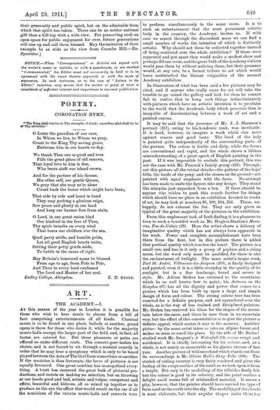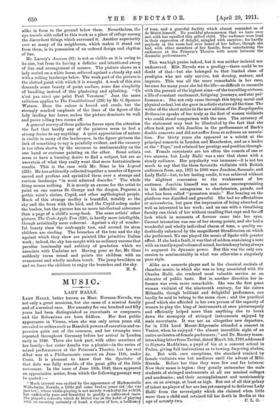ART.
THE ACADEMY.—I.
AT this season of the year in London it is possible for those who wish to hear music to choose from a bill of fare comprising entertainments of all kinds. Classical music is to be found in one place, ballads at another, grand opera is there for those who desire it, while for the majority music-halls occupy the larger part of the field, and, in fact, all tastes are catered for. But these pleasures or pains are offered us under• different roofs. The concert-goer makes his choice, and is not forced to sit through a musical comedy. in order that he may hear a symphony which is only to be heard played between the Acts of The Girl from somewhere or another. If the musician is thus fortunate, the lover of pictures is not equally favoured. One great combine has monopolised every- thing. A trust has cornered the great bulk of pictorial pro- ductions, and insists on making no selection, but on throwing at our heads good and bad, artistic and vulgar, competent and effete, beautiful and hideous, all so mixed up together as to produce on the eye the effect that would result on the ear if all the musicians of the various music-halls and concerts were
to perform simultaneously in the same room. It is to such an entertainment 1 hat the most prominent artistio body in the country, the Academy, invites us. If with care we search through the discordant mass we can find a small number of works the intention of which is distinctly artistic. Why should not these be collected together instead of being scattered over the whole exhibition P If these were separated and put apart they would make a modest show and perhaps fill one room, and the great bulk of the Academy visitors would pass them by without noticing them; but their presence would, at any rate, be a formal tribute to art which would leave undisturbed the blatant vulgarities of the normal Academy exhibition.
In illustration of what has been said a few pictures may be cited, and if anyone who really cares for ar•t will take the trouble to go round the gallery and look for them he cannot fail to realise that to hang such things indiscriminately with pictures which have an artistic intention is to proclaim to the world that the Academic body which proceeds thus is incarable of discriminating between a work of art and a painted canvas.
It may be said that the presence of Mr. J. J. Shannon's portrait (317), owing to his Academic rank, was inevitable. It is hard, however, to imagine a work which sins more against reason and good taste. The head of the lady is painted quite independently of the surrounding parts of the picture. The colour is feeble and dirty, while the forms are conventional and vapid, and the whole shows a lifeless misunderstanding of a great epoch of English painting in the past. If it was impossible to exclude this portrait, this was not the case with Mr. Peacock's family group (431). Through- out this picture all the trivial details—the pattern of the boys' kilts, the hoofs of the pony, and the stones on the ground—are painted with equal emphasis with the faces. No attempt has been made to unite the figures into any design. They stand like ninepins just unpacked from a box. If there should be anyone who wishes to push this search further for things which should have no place in an exhibition devoted to works of art, he may look at numbers 8], 100, 194, 256. These, un- happily, do not exhaust the list. They are only given as typical of the great majority of the pictures in the exhibition.
From this unpleasant task of fault-finding it is a pleasure to turn to such a beautiful work as Mr. Hughes Stanton's Moon- rise, Pas-de-Calais (29). Here the artist shows a. delicacy of imaginative quality which has not always been apparent in his work. Power and complete accomplishment have been there from the first, but in this picture there is added that poetical quality which touches the heart. The picture is a small one, and has in it only a group of poplars and a rising moon, but the word only must be qualified, for there is also the enchantment of twilight. The same artist's larger work, Fort St. Andre; Villeneuve-lea-Avignon (470), is finely designed and painted, even if it is a little everyday in the quality of its sunlight, but is a fine landscape, broad and severe in style. Mr. Adrian 'Stokes has returned to the mountains which he so well knows how to paint; his Autumn on the Simplon (67) has all the dignity and power that comes to a picture which has been built up upon a large and simple design of form and colour. The strong colour here has been reserved for a definite purpose, and not squandered over the whole, as is the way of less trained and disciplined painters. Mr. Stokes has reserved his blues for the slopes of the moun-
tain below the snow, and there he uses them in no uncertain way; but the effect of this concentration is to give the picture a
definite appeal, which makes it stay in the memory. Another picture by the same artist takes us into an Alpine forest and makes us seem to smell the pines. By the side of Mr. Stokes' studied work Mr. Sargent's A Waterfall (94) seems rough and accidental. It is chiefly interesting for its colour, and, as a whole, is not nearly so memorable as his glacier stream of last year. Another picture of wild moorland which stands out from its surroundings is Mr. Oliver Hall's Shap Fells (396). The stretch of rolling country is very finely rendered and gives the feeling of the rough surface of the earth as we look upon it from a height. Not only is the modelling of the hillsides finely felt but the colour is good in its sobriety, and the point surface a delight amid rooms full of mishandled material. It seems a pity, however, that the painter should have carried the type of form used on the earth into the sky. The modelling of the clouds is most elaborate, but their angular shapes make them too
alike in form to the ground below them. Nevertheless, the eye travels with relief to this work as a place of refuge among the discordant things which surround it. Another superiority over so many of its neighbours, which makes it stand out from them, is its possession of an ordered design and rhythm of line.
Mr. Lavery's Amazon (85) is not as visible as it is owing to its size, but from its having a definite and intentional sweep
of line and arrangement of masses. The picture shows us a lady seated on a white horse, relieved against a cloudy sky and with a rolling landscape below. The weak part of the picture is
the clotted paint with which it is wrought. A work of this size demands some beauty of paint surface, some fine simplicity of handling instead of this plastering and splashing. " Ce n'est pas ainsi que peint Paul Veronese." Just the same criticism applies to The Constitutional (236) by Mr. G. Spencer Watson. Here the colour is forced and crude, but the strongly marked emphasis of the lines of the figure of the lady leading her horse, makes the picture dominate its wall and prove telling two rooms off.
A general survey of these galleries forces upon the attention the fact that hardly any of the painters seem to feel a strong desire to say anything. A quiet appreciation of nature is visible in many of the landscapes, in the figure pictures the lack of something to say is painfully evident, and the vacancy is too often shown by the recourse to sentimentality on the one hand or costume painting on the other. Some artists seem to have a burning desire to find a subject, but are so uncertain of what they really want that mere fantasticalness results. This is the case with Mr. Sims in his Legend (221). He has arbitrarily collected together a number of figures sacred and profane and sprinkled them over a strange and curious landscape " in most admired disorder." The whole thing means nothing. It is merely an excuse for the artist to paint on one canvas St. George and the dragon, Pegasus, a gothic saint's shrine, Cupid, and other mythological people. Much of this strange medley is beautiful, notably so the sky and the trees with the bird, and the Cupid asleep under the bushes, but the picture has no more intellectual coherence than a page of a child's scrap-book. The same artists' other picture, The Crab-Apple Tree (226), is hardly more intelligible, though artistically more coherent. Against a sky of wonder- ful beauty rises the crab-apple tree, and around its stem children are circling. The branches of the tree and the sky against which they show are painted like primitive Italian work ; indeed, the sky has caught with no ordinary success that peculiar luminosity and subtlety of gradation which we associate with Umbrian art. Having gone so far, Mr. Sims suddenly turns round and paints the children with an evanescent and wholly modern touch. The jump bewilders us and we leave the children to enjoy the branches and the sky.
H. S.



























































 Previous page
Previous page